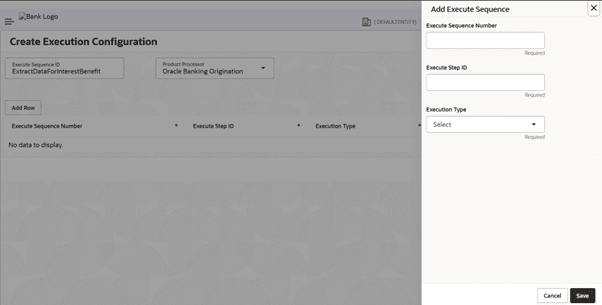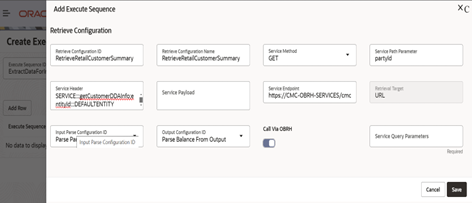3.20.3.1 Create Execution Configuration
This topic describes the systematic instructions on configuration on execution.
- On Homescreen, click Core Maintenance, under Core Maintenance, click Credit Decision.
- Under Credit Decision, click
Maintenance, under
Maintenance, click Execution
Configuration, under Relationship Pricing
Configuration, click Create Execution
Configuration.The Create Execution Configuration screen is displayed.
Figure 3-146 Create Execution Configuration
- On Create Execution Configuration screen, Specify the
fields.For more information on fields, refer to the field description table.
Note:
The fields marked as Required are mandatory.Table 3-125 Create Execution Configuration - Field Description
Field Description Execute Sequence ID Specify the unique execute sequence ID. Product Processor Select the product processor from the drop-down list for which configuration is being created. Execute Sequence Number Specify the unique sequence number for the execute sequence table. Execute Step ID Specify the unique step ID for the execute sequence table. Execution Type Select the type from the drop-down list. The available options are: - Parse
- Retrieve
- Store
- On Add Execute Sequence screen, select the execution
type to maintain the configuration.
- Select the Execution Type as
Retrieve and click Create Retrieve
Configuration to provide the details or click
Existing Retrieve Configuration and select the
Retrieve Configuration ID from the list.The Retrieve Configuration screen is displayed.
Facts can also be fetched from external domains by making rest calls. The configuration will store details like the type of rest call (GET/POST), service URL, service headers, query params, whether the call is happening via OBRH or not. This configuration also links a parse config id which will extract the facts from response.
For more information on fields, refer to the field description table.Table 3-126 Retrieve Configuration - Field Description
Field Description Retrieve Configuration ID Specify a unique Retrieval configuration ID. Retrieve Configuration Name Specify a unique name for the Retrieval configuration ID. Service Method Select the service method from the drop-down list. The available options are: - GET
- POST
Service Path Parameter Specify the list of path parameters, separated by #. Service Header Specify the list of service headers, format: (header1:::value1;header2:::value2). Service Payload Specify the request body, if any. Service Endpoint Specify the endpoint being configured. Retrieval Target Displays where to retrieve data from. The options are: - URL
- LOCALCACHE
- COHERENCECACHE
Input Configuration ID Select the input parse configuration ID, used for parsing data needed for input. Output Configuration ID Select the output parse configuration ID, used for parsing response of API call. Call via OBRH Click the toggle status to check if the endpoint is configured via OBRH. Service Query Parameter Specify the list of query parameters, separated by #. - Select the Execution Type as
Parse and click Create Parse
Configuration to provide the details or click
Existing Parse Configuration and select the
Configuration ID from the list.The Parse Configuration screen is displayed.
For more information on parse configuration, refer
- Select the Execution Type as
Store and click Create Store
Configuration to provide the details or click
Existing Store Configuration and select the
Store Configuration ID from the list.The Store Configuration screen is displayed.
Store configuration can be used to store attributes that are parsed and/or retrieved into RP fact tables.
Store configuration should be the last step in an execution sequence, and it should be preceded with at least a parse or retrieve configuration.
For more information on fields, refer to the field description table.Table 3-127 Store Configuration - Field Description
Field Description Store Configuration Specify a unique Store configuration ID. Store Configuration Name Specify a unique name for the Store configuration ID. Product Processor Select the product processor from the drop-down list for which configuration is being created. Aggregate Select the attaching aggregate name to store configuration. - Click Save to save the details.The Create Execution Configuration is successfully created and can be viewed using the View Execution Configuration screen.
Parent topic: Execution Configuration



